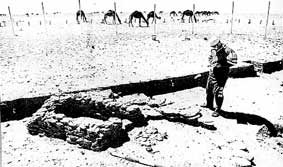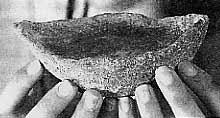A BRITISH team of archaeologists believes that small slabs of bitumen dug up in Kuwait could hold evidence that man first successfully built ocean-going boats up to 7,000 years ago.
The bitumen pieces, dating from 5,000BC, are indented on one side by impressions of reeds and encrusted with barnacles on the other. The team, led by Robert Carter, from University College London, made the discovery while unearthing a Neolithic human settlement at Subiya, on the northern shore of Kuwait Bay, at the top of the Gulf.

The Subiya site in Kuwait yielded pieces of bitumen from 5,000BC, evidence of early boat building, while archaeoligists were unearthing a Neolithic human site
“From the point of view of early trade, and early seafaring, this is a very, very important find,” said Dr Carter. ‘These are certainly the earliest fragments of boats ever found in the Gulf, and possibly in the world.”
The team, which included archaeology experts from Cambridge and York universities, said what made the dig particularly exciting had been the discovery of a model boat from the same periods.
“It has a surprising amount of detail on it, telling us a lot about how this Stone Age community constructed its boats. There are lines coming down from the prow and the stern, which may be junctions of reed bundles, or ropes, and it’s got two indentations at each wood were laid across it,” Dr Carter said.
The Subiya site was first identified 15 years ago by Fahad Al-Wahaibi, the former director of Kuwait’s National Museum, when he noticed a mound in the desert with an unusual number of flint shards scattered around it.
“I used to go to that area regularly on fishing trips,” said Dr Wahaibi, “and I discovered several sites that I suspected were linked with ancient human settlements.”
Sean Mcgrail, a professor of maritime archaeology at Southampton University, said that the find, if authenticated, would be highly important “since very little is known about the origins of boat building”.
“The earliest plank boats known until now were excavated from a tomb at Cheops, in Egypt, and dated back to 3,000BC.”
Excavation of Subiya site began only two years ago, after Dr Wahaibi met Harriet Crawford, of UCL’s Institute of Archaeology, at a conference and invited her to lead a team there. In its first two seasons, the Kuwait-British Archaeological Expedition unearthed a complex series of small buildings made from slabs of local sandstone and evidence of an independent local economy based on fishing, animal husbandry and making beads and jewellery form seashells.
Pieces of flint, quartz and shell were turned into axes, arrowheads and drills. The arrowheads would be stuck into wooden shafts and thrown or fired from a bow to kill birds, gazelles and fish. The shells would be shaped and drilled to make jewellery, which in turn was traded for pottery from Mesopotamia to north, for animals throughout the Arabian Peninsula.
Besides flint and quartz, obsidian, a natural volcanic glass, was also found at the site, which the team first thought came from Anatolia in Turkey. Further research however, was established that it originated in Yemen. “That’s over 1,000 miles away,” said William Davies, of Cambridge University, “which gives you an idea of what a wide trading network there was at the time.”
The real excitement, however, came this spring with the discovery that boats might have extended the Neolithic trading network throughout the Gulf. “We’re going to analyse the bitumen and see whether it came from Iraq, Kuwait or Iran,” said Dr Carter. “This might tell us more about where these people sailed to because these boats were unable to tack in the wind. With the prevailing winds coming from the northwest, they would have had to sail down the Gulf. One of the only ways to get back again would be to cross over to Iran, and pick up the anti-clockwise currents which run from south to north.”

The model boat found at Subiya holds details of ancient construction methods
Confirmation of the boat findings depends on further analysis to be carried out later this month by Tom Vosmer, a contemporary boat expert form Curtin University in Australia. “He will look for structural information form the bitumen,” said Dr Carter. “He will try to identify the reed species, determine how the reed bundles were created and joined, decide whether wood was involved, and see how the pieces and technology compare to later Bronze Age examples.”
For Kuwait, stung by the recent suggestion by Saddam Hussein’s son, Uday, that cartographers should redraw maps to show the oil-rich emirate as no more that a province of “greater Iraq”, the discovery of its possible 7,000 year old heritage could not have come at a better time. Subiya Man is already being heralded as “the first Kuwaiti”, even though human remains have yet to be found in the sand.
ByThe Sunday Telegraph - Richard Weekes